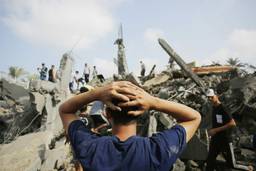Youth Gone Wild
Jared Cohen’s book Children of Jihad: A Young American’s Travels among the Youth of the Middle East seeks to understand an area of the world where hatred for his country and religion run rampant
Brent White
In the summer of 2006, only a few days before the 34-day war between Israel and Hezbollah rocked the Lebanese capital and killed 6,000 people, Jared Cohen, a young American Jew, dined at a McDonald’s in Beirut. His companions that day were young members of Hezbollah, the anti-Israeli group that the U.S. State Department has labeled a terrorist organization. The young men, dressed in Armani jeans and Versace sweaters, and sporting hip haircuts, gawked as women walked by.
Cohen was interviewing the men for his book, Children of Jihad: A Young American’s Travels among the Youth of the Middle East (Gotham). His research took him on a two-year journey to Iran, Syria, Lebanon and Iraq.
His quest to understand an area of the world where hatred for his country and religion run rampant make the Oxford graduate and Rhodes Scholar’s book an eye-opening read. By looking specifically at the idealistic, hopeful and progressive youth throughout the Middle East, he hopes to get a better grasp on the current sway of anti-Americanism, and its future prospects.
Children of Jihad debunks many of the West’s cherished myths of the Middle East. Cohen begins his travels in Iran. “The media had shaped my impression of Iran as deeply religious, anti-American and extremist society,” Cohen writes, “and now I was prepared for the worst.” After discovering that most Americans traveling in the country are assigned a “tour guide,” which Cohen sees as a euphemism for a government spy, he manages to sneak into the University of Tehran where he befriends a group of young women. They are progressive thinkers, he finds, politically engaged and distrusting of Iran’s clerics and its government. “When you go back [to America], you must tell people that Iranians have no problems with Americans,” one of the women tells him.
In what he describes as a “passive revolution,” Cohen writes that the youth of Iran sidestep their oppressive regime by partying and partaking in new technologies, like Bluetooth cell phones, satellite dishes and social network websites like MySpace. Like satellite dishes, alcohol is illegal in Iran, yet Cohen finds plenty of it at a party, fueling fierce debates between progressive young Iranians and nationalists who support Iran’s right to nuclear power.
Cohen finds a similar dynamic when he travels to Beirut and visits the city’s progressive and party-happy youth. He attends a beach party where Muslims, Christians, Druze, Palestinians, Syrians and other Middle Eastern youth party until dawn, listening to Middle Eastern and Western music.
The most impressive part of Children of Jihad comes when Cohen travels to the Palestinian refugee camps in Lebanon. Through his connections with members of Hezbollah, Cohen gains entry to Ayn al-Hilwah, the largest Palestinian refugee camp in Lebanon. Home to more than 44,000 refugees, it’s a prime spot for terrorist recruiters, and, arguably, one of the most lawless areas of the world.
Cohen interviews General Mounir Maqdah, chief military authority over the 350,000 Palestinians living in Lebanon. “It was hardcore and frightening,” Cohen writes. During the interview, Maqdah expresses admiration for al Qaeda leader Osama bin Laden, and the two speak about the Palestinian people’s struggle.
In the chilling pages that follow, Cohen is lead out of the compound by young men who take him to a room filled with guns, knives, grenades and other instruments of death. The young men playfully make Cohen wear a vest and fill it with handguns, axes and grenades. But Cohen is surprised to learn of their desire for peace.
“None of these boys expressed a love for violence,” Cohen writes. “Despite their gaudy displays of weaponry and the ominous threat of physical violence that bubbled just beneath the surface, I could see that these youth were weak and broken inside.”
Unfortunately, when Cohen isn’t telling the story of the so-called “Children of Jihad,” he is obsessively documenting his every experience, no matter how dull. But even if Cohen isn’t much of a storyteller, the lengths he goes to tell this one is commendable. He provides a compelling, if far too brief, portrait of an often-overlooked demographic of the world – one who will, Cohen reminds us, undoubtedly be responsible for creating and shaping the ideas and alliances necessary to achieve the lasting peace sought by the youth in every part of the world.





